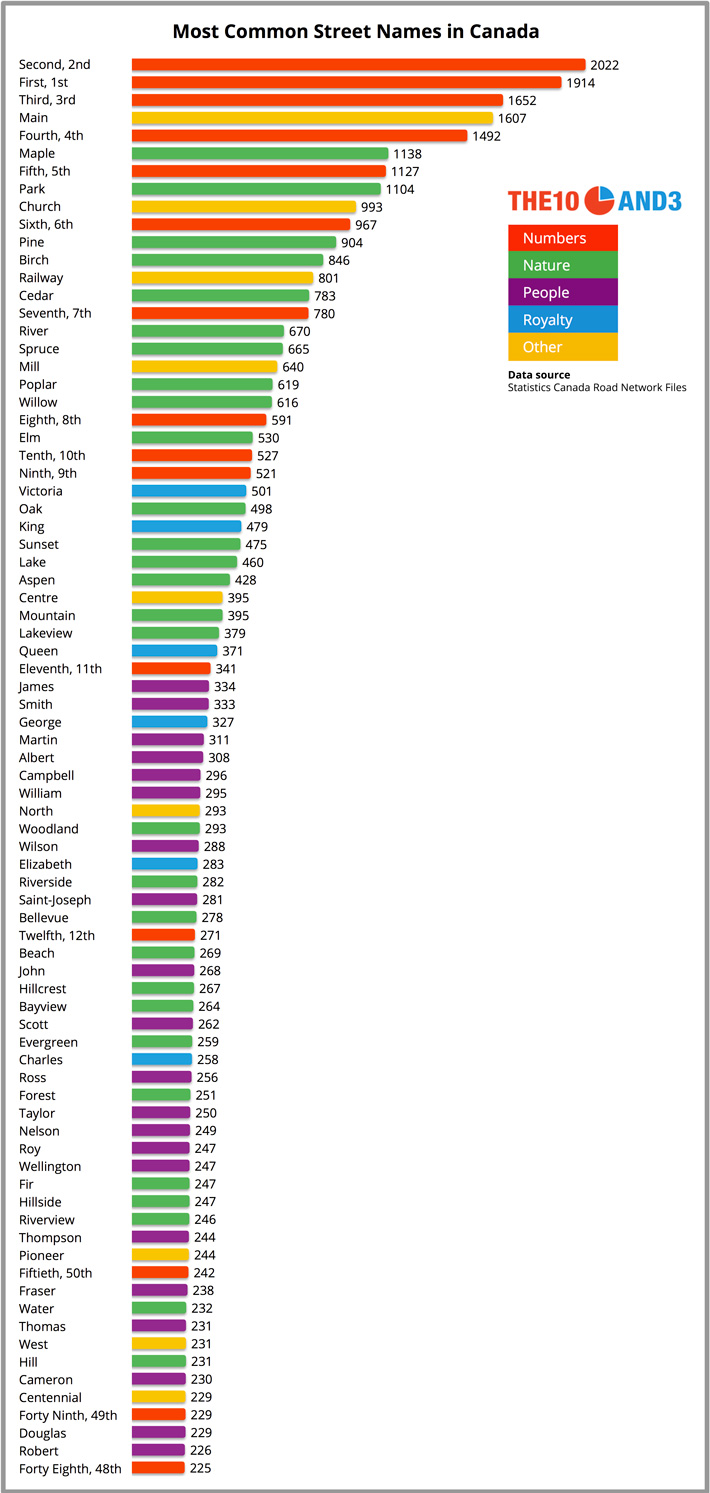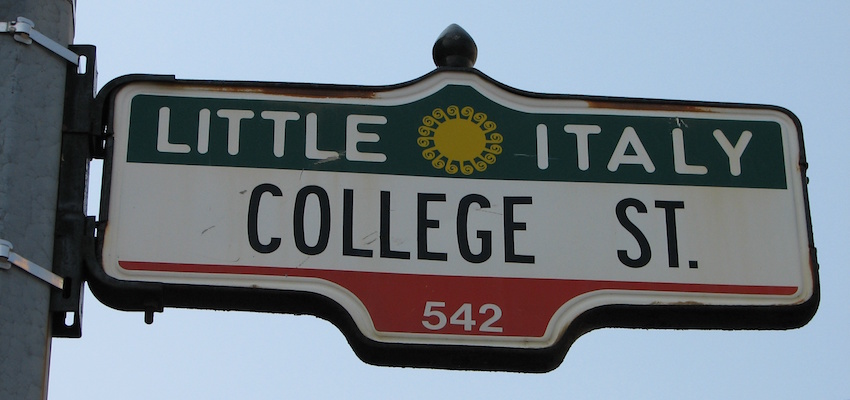It’s 7204 km from Victoria, British Columbia in the west to St John’s, Newfoundland in the east, and 4529 km between Alert, Nunavut in the north and Windsor, Ontario in the south. Connecting this big, beautiful landmass is a network of thousands of roads, all named after something or someone. This got us thinking: what are the most popular names among Canadian streets? How do their numbers reflect the values and history of the Great White North?
As it turns out, Canada’s most common street name is a number: Second. But this finding isn’t actually that surprising, as Second is also the most popular street name in America, according to an article from FiveThirtyEight. Numerical street names in fact feature quite prominently in our list. Out of the top ten names, six are numbers (it’s seven out of ten for American street names). But there are a few key differences that distinguish Canada’s list from America’s. Maple cracks the Canadian top ten, for instance. There are also nods to the British royalty as well as to our French heritage, and references to famous Canadians throughout history. Second may be the top name for practical reasons, but the rest of the list provides a window into Canada’s culture and values.
We wanted to produce the most holistic and accurate list of street names in Canada, and extracted this data from Statistics Canada’s Road Network Files for 2015. We computed the 80 most common names after combining numerical monikers like “First”, “1st”, “1E” and “Premier” together; moreover, French words (apart from proper nouns) were included with their English translation in the final count. For example, the common Quebec street name “l’Église” was combined with the common English Canada street name “Church”.

Numbers
Of course numerically named streets are common, but it’s notable that Second (at 2022 occurrences) — and not First — is the top street name in all of Canada. This is because streets named Second do not necessarily follow a First street. As explained in FiveThirtyEight’s analysis of American street names, Second will often come after whatever serves as a city’s primary thoroughfare, be it First Street, Main Street, Front Street or something else (see Lakeview, Nova Scotia, for instance). The numbers continue in the list in relatively ordinal fashion up to Twelfth, after which the next most common street name number is Fiftieth (242). That’s a pretty big jump between street numbers.
The popularity of Fiftieth comes from Alberta, where the intersection of 50th Avenue and 50th Street serves as the midpoint of many urban municipalities – 41% of the province’s cities follow this pattern. The model of assigning high numbers to the streets at a city’s midpoint is said to have spread from Edmonton (which centres at 101st and 101st/Jasper), and became a popular and easy navigation system among central and northern Alberta towns. In the 1920s the prominent natural gas supplier Northwestern Utilities liked Edmonton’s approach so much that they incorporated it into their expanding gas network – a city had to adopt the 50th Avenue/50th Street midpoint in order to get Northwestern Utilities’ services.
Nature
References to nature dominate the list, which is not surprising since Canada is a veritable blanket of breathtaking natural scenery. These mostly appear in the form of tree species and landscapes rather than animals – perhaps “Moose Street” or “Caribou Crescent” couldn’t be taken seriously by developers. Only the noble Canadian Beaver (154) makes it onto the list. The most common reference to nature is Maple (1138), the emblem on the nation’s flag and symbolic of the syrup for which Canada is so well known. This is followed by Park (1104) and Pine (904), Canada’s most common conifer.
The list of American street names also featured many references to nature, but Canada’s includes some absent from the American list – Mountain (395) and Evergreen (259), for instance. Other nature names unique to Canada’s most popular list include Aspen (428), Riverside (282), Beach (269), Bayview (264), Hillside (247), Riverview (246) and Water (232).
Royalty
It comes as little surprise that names of royal descent appear on the list before those of famous Canadians. Victoria (501), King (479) and Queen (371) are more common than any historic Canadian, a testament to our enduring if not complicated ties to the British monarchy. After all, Queen Victoria has 501 streets named after her and a federal holiday to boot, while Canada’s first Prime Minister, John A. MacDonald, didn’t even make it onto the list. Now the Widow at Windsor can add “most common street named after a person in Canada” to her list of accolades.
Other names’ origins remain ambiguous. Are they tied to royalty or not? For instance William (number 42 on the list with 295 streets) could be King William IV of the United Kingdom, William Lyon MacKenzie, or another William entirely. We just don’t know.
Famous People, Places and Monuments
There are some streets with obvious references to famous Canadians, however. Campbell (296) is likely in honour of one of Canada’s Fathers of Confederation, Sir Alexander Campbell. Fraser (238) is probably in recognition of Simon Fraser, acclaimed explorer and fur trader. Same for Thompson (244), likely named for the explorer and cartographer David Thompson.
Bellevue (278) is one of the only names on the list referring to a specific place or monument. Some of these streets could be named after Sainte-Anne-de-Bellevue, one of the oldest communities in Montreal. Others could be for Bellevue House, an elaborate villa that was leased to John A. Macdonald before his time as Prime Minister. Also in this category is Saint-Joseph (281). These streets could be named after Montreal’s largest church, Saint Joseph’s Oratory of Mount Royal in Montreal, the various towns named Saint-Joseph, or for the Great Saint of Everyday Life himself.
As with royalty, it can be hard to determine which famous person these streets are recognizing. James (334) could be in honour of Welsh sea captain Thomas James, for whom James Bay is also named. Some could be in honour of King James. But really, the name James is so common it’s impossible to determine exactly which famous James is being saluted. Same with streets named Douglas (229), which may pay tribute to David (namesake of the Douglas fir) or Sir James (Governor of Vancouver Island and British Columbia).
So what can a list like this really reveal about Canada’s history and values? While it is certainly shaped in part by regional quirks, the list does seem to suggest certain ineffable values: British before Canadians, Maples before Pines, cartographers before fur traders. Regardless, we’ve confirmed that Canadians not only love their trees, but love naming their streets after them – especially trees that provide the delicious nectar so emblematic of the country’s soul.
Methodology
We used StatsCan’s comprehensive mapping database that includes every street in Canada. We grouped streets together in the list in the following cases: a) numbered streets that have essentially identical meanings, such as First/1st/1/1e (streets like 1A, 1B were not grouped because they tend to exist where there is already a First/1st Street) and b) French words were combined with their English equivalents, such as Church and l’Église. Most streets are easily classified according to nature, royalty, etc., though some required an arbitrary decision (ex. classifying Charles as royalty).
Don’t miss our newest stories! Follow The 10 and 3 on Facebook or Twitter for the latest news and analysis.
